Armored cars Standard Beaverette (UK)
Already in June 1940, shortly after the evacuation of troops, the first proposals for future rearmament and replenishment of losses appeared. The author of one of these proposals was William Maxwell Aitken, 1st Baron Beaverbrook, who was then Minister aviation industry. He recalled that the Royal Air Force had already managed to place an order for a number of new armored cars needed to protect airfields. In addition, he had information according to which the automobile company Standard Motor Company had about five hundred wheeled chassis idle idle and suitable for use in emergency re-equipment.
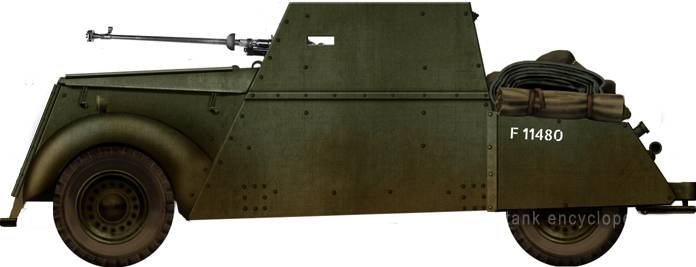
Reconstruction of the appearance of the Beaverette Mk I armored car armed with a Boys anti-tank rifle. Figure Tanks-encyclopedia.com
Lord Beaverbrook offered to develop a new armored car based on the existing chassis of the Stender company. By equipping the existing wheeled vehicle with a new armored hull, an armored car with acceptable characteristics and capabilities could be obtained. The most important features of such a project were to become cheap and easy to build serial equipment. Such prospects and, possibly, some assistance from the Minister of Aviation Industry led to a positive decision of the command.
The development of the new armored car started before the end of June 1940, and did not take much time. The project to rebuild the serial chassis was carried out by the designer Mark Aitken and the captain John Black. The nickname that beats the title of the initiator of the development, Beaverette, stuck fast enough to the project. In the future, the nickname has become the official designation. He was also joined by the name of the automobile manufacturer of mass-produced cars, with the result that an interesting sample remained in stories under the name Standard Beaverette. Later, one of the new modifications of the armored car was called the Beaverbug.
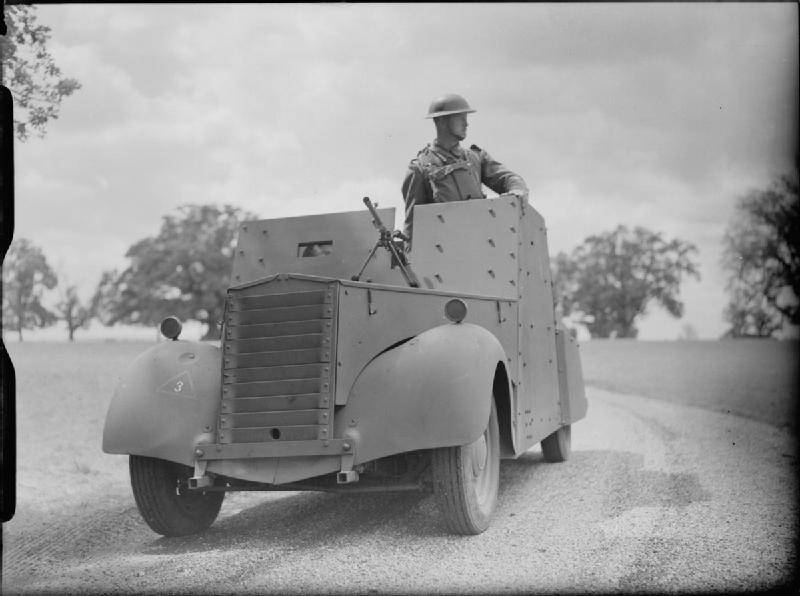
One of the first armored vehicles of the Beaverette Mk II type, which entered service in the 7 th Dragoon regiment, July 25 1940. Photo by Imperial War Museum / iwm.org.uk
In connection with the latest unfortunate events, the British defense industry was forced to urgently increase the production of high-grade military equipment of the existing types, which had some negative impact on the original design of the light armored car. Thus, the lack of rolled metal made the developers build a new armored hull with extensive use of sawn timber. It was not possible to "knock out" and armor steel, because of which the body was planned to be assembled from boiler iron. All this should have been to a certain extent limit the real characteristics and capabilities of the armored car, but in that situation it was not necessary to choose.
At the heart of the first version of the armored car called the Beaverette Mk I was the serial car chassis of the brand "Standerd". Like many other cars of the time, it was built on the basis of a metal frame and had a bonnet layout. In front of the frame was mounted gasoline engine Standard brand power 48 hp With the help of a mechanical transmission, torque was given to the rear axle. The chassis had a dependent wheel suspension on leaf springs. In the basic design, a similar chassis was equipped with a closed body, which allowed to carry passengers and some small loads.
M. Aitken and J. Black developed a fairly simple protected enclosure that met the requirements of the existing chassis. On the wooden frame were mounted several flat metal parts, forming the necessary volumes, as well as protecting the power plant and the crew. For some security enhancement, it was decided to use a combined reservation. Iron sheets 8-9 mm thick were installed on top of 3-inch (76,2 mm) oak boards. Such panels with the help of standard fasteners were mounted on the existing frame.
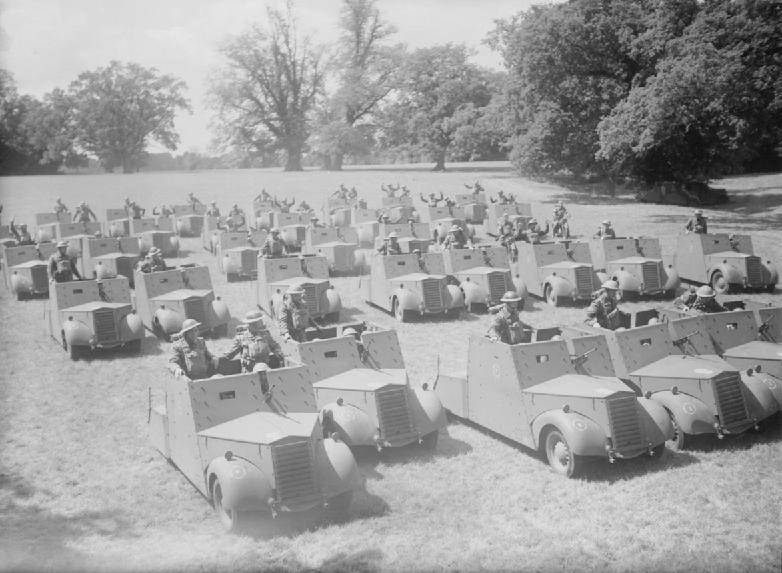
Solemn acceptance ceremony for new equipment, 25 July, 1940. Photo by Imperial War Museum / iwm.org.uk
The engine was covered with a simple form of the hood, which had an inclined front sheet with vertical louvers for air supply, diverging to the sides of the sides and an L-shaped lid of two parts. To save, it was decided to keep the existing wings curved shape. They were placed in the corresponding openings of the side sheets.
The habitable compartment of the Mk I armored car was covered only with a half-open wheelhouse. She received an inclined frontal sheet with a set of hatches, as well as a pair of trapezoidal side parts of a vertical location. The back of the car, including the wheels, was covered with a box-shaped unit of a simple form. It had slightly converging side plates of low height, a sloping roof, and a stern detail piled forward. Such a design of the rear of the case to some extent facilitated the landing in the car.
The front sheet of the habitable compartment received a rectangular viewing hatch on the right side and a vertical slot-embrasure on the left. Inside the cabin there were four simple crew seats. It also envisaged the use of simple means of assembling one or another weapon, ammunition storage systems, etc.
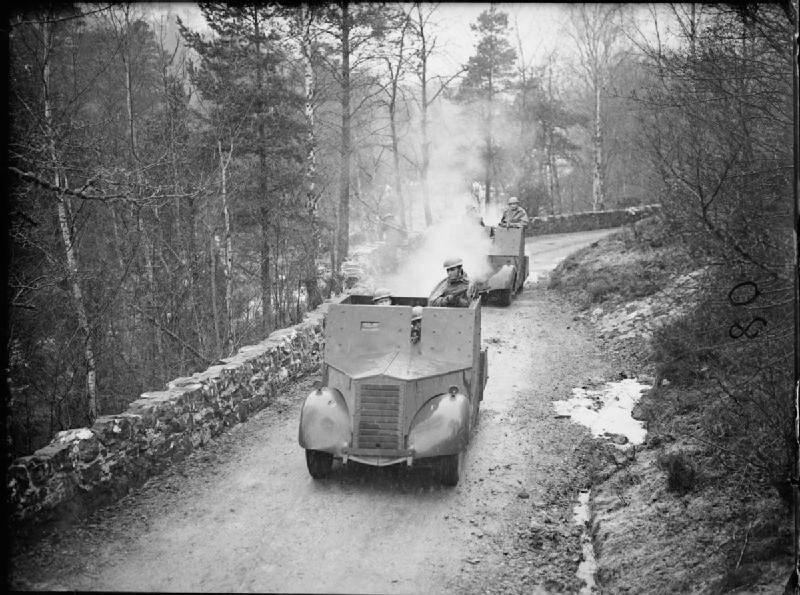
The Scottish militia patrols on the armored vehicles of the second model, February 14 1941. Photo by Imperial War Museum / iwm.org.uk
The standard crew of the Standard Beaverette Mk I armored car consisted of two or three people. The driver was in front of the cabin, on the starboard side. To his left was placed the shooter. The commander was supposed to be in one of the rear seats. The crew could observe through hatches and gaps in the hull. The possibility of observing over the sides was also not excluded. As the main weapon of the armored car, it was proposed to use the BREN machine gun or the Boys anti-tank gun. The weapon was placed in the frontal installation of the body and could attack targets in the front hemisphere. Depending on the available capabilities, the armored car could be equipped with other small arms. The possibility of using personal weapons of the crew was also not excluded.
The armored car of the first version had a length of 4,11 m with a width of 1,6 m and a height of 1,52 m. Combat weight - 2 t. The original protected body corresponded to the chassis capabilities, which made it possible to obtain acceptable mobility. According to reports from the British press of the time, Standard Beaverette could reach speeds of up to 60 miles per hour (almost 100 km / h). Power reserve - a few hundred kilometers.
The first armored cars of the new type were made already in the summer of the 1940 of the year and soon went to different parts of the army. For obvious reasons, this technique was not considered as the basis of the fleet of combat vehicles, but in the event of a negative development of events, she too would have to go into battle. It is unlikely that she could count on particular success, since she did not have high combat characteristics. But the new armored cars Beaverette Mk I were simple to manufacture and could be produced in large quantities.
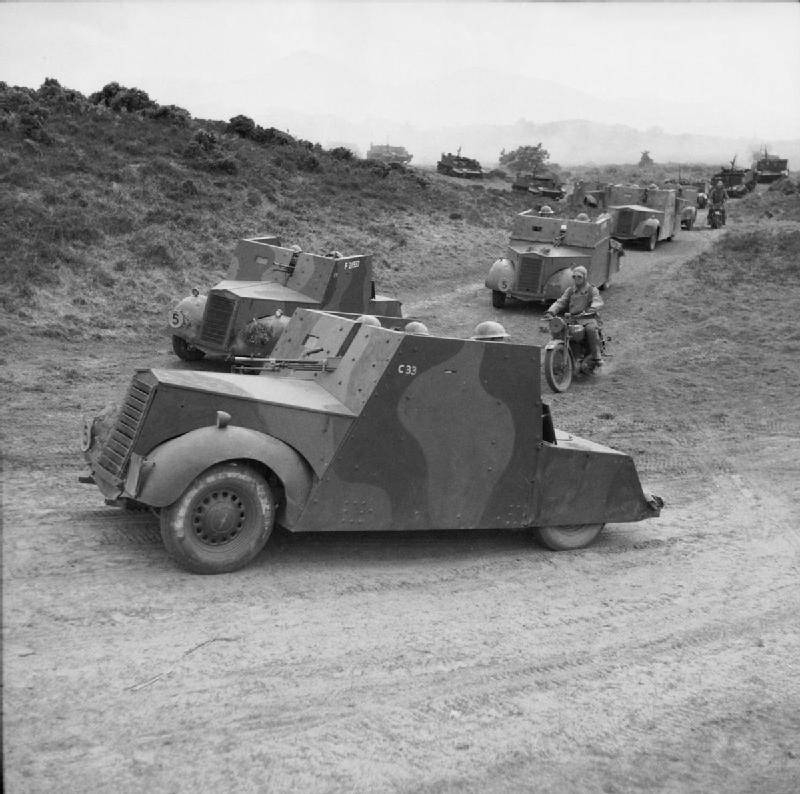
Beaverette Mk II on maneuvers in Northern Ireland, 19 June 1941. Photo by Imperial War Museum / iwm.org.uk
Until the end of 1940, the authors of the project managed to make a small upgrade. Given the operating experience of existing machines, a project was proposed with the additional designation Mark II. In general, he repeated the basic design, but had some differences. First of all, managed to find the required armor. Instead of boiler iron, sheets of steel armor with a thickness of up to 10 mm are now used. At the same time, the combined protection with the use of oak boards was maintained.
To improve engine protection while maintaining the required ventilation, the vertical slots in the front plate were replaced with horizontal blinds. In addition, the habitable compartment received a stern leaf, although it still did not have a roof. For the convenience of planting, the upper part of the aft logging room was mounted on hinges and could be folded down and back. The rest of the case remained the same. Characteristics of the car almost unchanged.
In 1941, a fundamentally new modification of the Standard Beaverette Mk III appeared. For its distinctive appearance, she received the nickname Beaverbug. As part of this project, the manufacturing company reworked the existing chassis and reduced its length. The frame, reduced by about a meter, made it possible to optimize the layout and correctly use all the available possibilities. In addition, for the armored car of the third model, a new building was created with improved technical and operational indicators.
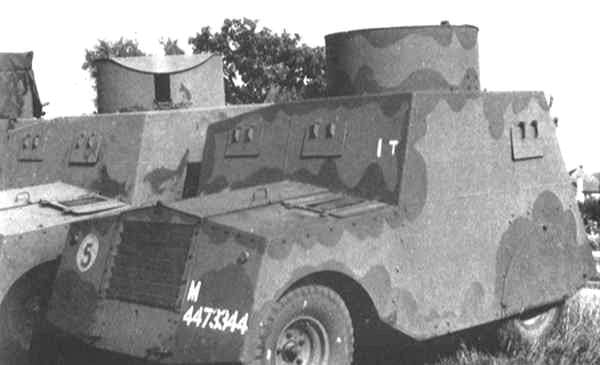
Armored cars modification Mark III. Photo Aviarmor.net
Unlike previous machines of the family, the Beaverette Mk III had to be equipped with a fully enclosed armored body welded and riveted only from steel sheets with a thickness of up to 10 mm. The engine was covered with an increased hood. It had a wide sloping frontal sheet with a central opening covered with blinds. The side elements of this sheet covered the front wheels. There were vertical sides with slots under the wheels. The roof of the engine compartment, as before, consisted of two sheets, assembled in an L-shaped system. Its central element was a hatch flap.
The habitable volume of the body was equipped with a front sheet, installed with a slight tilt back. Vertical sides and an inclined feed detail were also envisaged. The roof of the habitable compartment had a wide horizontal left part, while its right element had smaller dimensions and was mounted with a slope. In the basic version, the armored car Mk III was equipped with a cylindrical turret with an inclined roof. Also could be used "combat modules" of a different design.
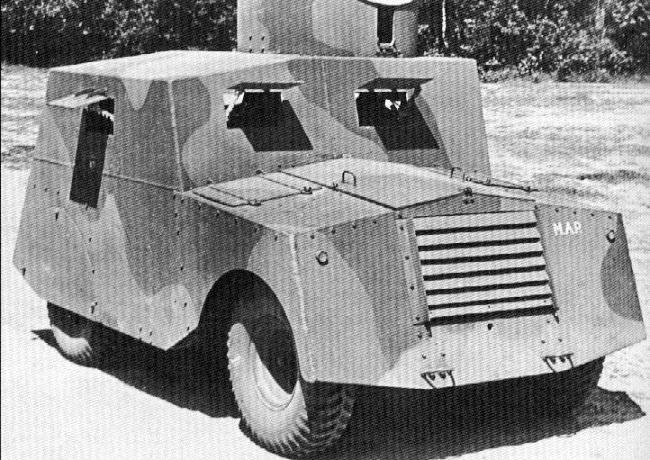
Beaverette Mk III from a different angle. Photo Aviarmor.net
The crew now consisted of three people. The driver and the commander were in front of the manned compartment and could follow the road with the help of inspection hatches in the front and side sheets. The shooter was placed behind the commander and controlled the tower armament. Access inside the armored car was provided by a large hatch in the inclined stern sheet.
Most of the armored cars of the third model received machine guns BREN. Depending on a number of factors, they could be installed both on an open turret and in a closed tower, and the towers of different series had a different design. In addition, the proposed installation of two Vickers machine guns, supplemented with an armor shield arrow. One of the armored vehicles in the pilot order received the Boulton-Paul aviation installation with four Browning rifle caliber machine guns.
After the first deep modernization, the Beaverette armored car changed its dimensions and was noticeably heavier. The length of the machine was reduced to 3,1 m, while the width and height increased to 1,73 and 2,16 m, respectively. The combat weight was now 2,6 t. The preservation of the already used powerplant and transmission resulted in a slight drop in mobility. Nevertheless, such shortcomings were completely leveled by the increase in combat qualities.
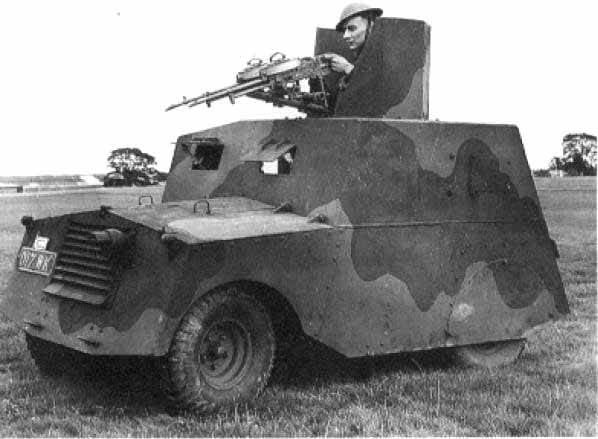
The standard tower was replaced with a shield with a machine gun spark. Photo Aviarmor.net
The result of the further development of the project was the appearance of the armored car Beaverette Mk IV. The only serious difference between this car and the Beaverbug was the increased booking of the frontal projection. Now the engine and the habitable compartment in front were covered with 12-mm armor. Also present were some or other improvements, primarily technological ones. Despite all the changes, apparently the third and fourth cars of the family were almost the same.
Standard Motor Company received the first order for the construction of Beaverette armored vehicles in the summer of 1940. The assembly of machines of the first series, which had an improvised combined protection based on boiler iron and wood, did not take too long. By the end of the year, it was possible to master the production of combat vehicles with full reservations. Later, a new shortened chassis and two more modifications of armored vehicles appeared. The assembly of such equipment at the Standerd plant continued until the 1942 year and was discontinued due to the appearance of the possibility of normal construction of full-fledged armored vehicles of various models. In less than two years, the army received about 2800 armored cars of four versions.
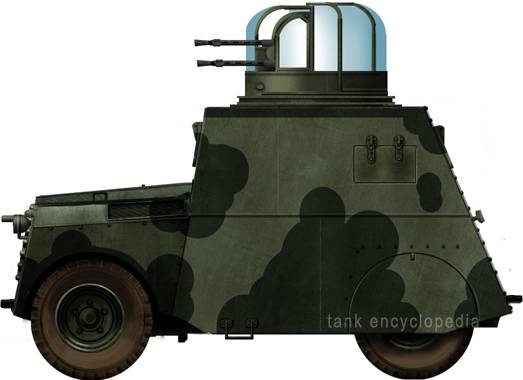
General view of the Beaverette Mk III armored vehicle with a Boulton-Paul machine gun turret. Figure Tanks-encyclopedia.com
At a certain point, the technical documentation on the armored cars of the Standard Beaverette was sent to New Zealand, where the production of similar vehicles soon began. The existing Ford trucks with a payload of no more than 1 tons were used as the basis for them. The armor for the vehicles was removed from old ships that were waiting to be cut in different ports. The assembly of armored vehicles was carried out in the railway workshops Hutt Valley. A similar version of the armored car was named Beaverette (NZ). For several months, only 208 improvised combat vehicles were assembled in New Zealand.
Standard Beaverette serial armored vehicles were distributed between various parts of the ground forces and the Royal Air Force. In addition, from a certain time began to receive such a technique and the formation of the national militia. The relatively high rates of serial construction made it possible to quickly re-equip a significant number of units and partially restore their combat capability. Thanks to this, in the most difficult period, the army should not have been left without any equipment, even if it was not distinguished by unique combat capabilities.
Lord Beaverbrook's armored cars played an important role in propaganda. Not the most perfect, but massive armored vehicles were supposed to show the desire of Great Britain to restore its defense capability, and also to demonstrate readiness to meet the enemy fully armed. Given the situation after the well-known events of the beginning of the summer of 1940, this effect from the new armored cars could not be underestimated either.
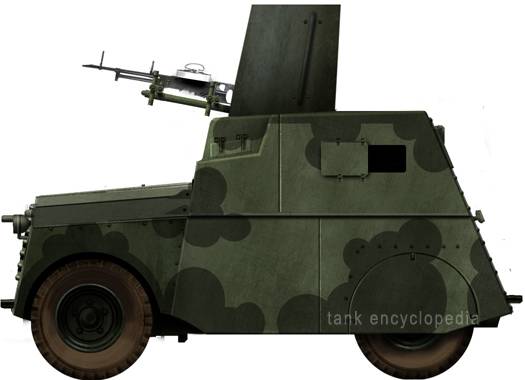
Beaverette Mk IV with a pair of machine guns. Figure Tanks-encyclopedia.com
At the same time, the operation of the new technology was associated with a lot of problems. Thus, the hull of new designs turned out to be quite heavy - an increased load quickly enough led to different chassis failures. In addition, the car chassis was not distinguished by high mobility and maneuverability on rough terrain. Desired characteristics could be obtained only on good roads.
Production of armored cars Standard Beaverette was completed in 1942 year due to the possibility of producing a sufficient number of more advanced technology. However, the operation of such machines continued until the very end of the war. Naturally, from a certain time such armored vehicles were considered solely as an addition to other samples and, as a result, were used to solve secondary tasks. Thus, over time, armored cars were abandoned to patrol roads and protect airfields.
The presence of a sufficient number of full-fledged armored vehicles allowed the UK not to attract the existing Beaverette to the fights. All similar cars remained in own territory. Because of this, they did not have the opportunity to participate in battles with the enemy. Nevertheless, a couple of crews still managed to shoot at the enemy. In April, 1943, guarding the airfield of RAF West Malling, which used Stenarder armored cars, was able to capture two German pilots. One of the FW-190 aircraft on which they flew was destroyed by machine gun fire.
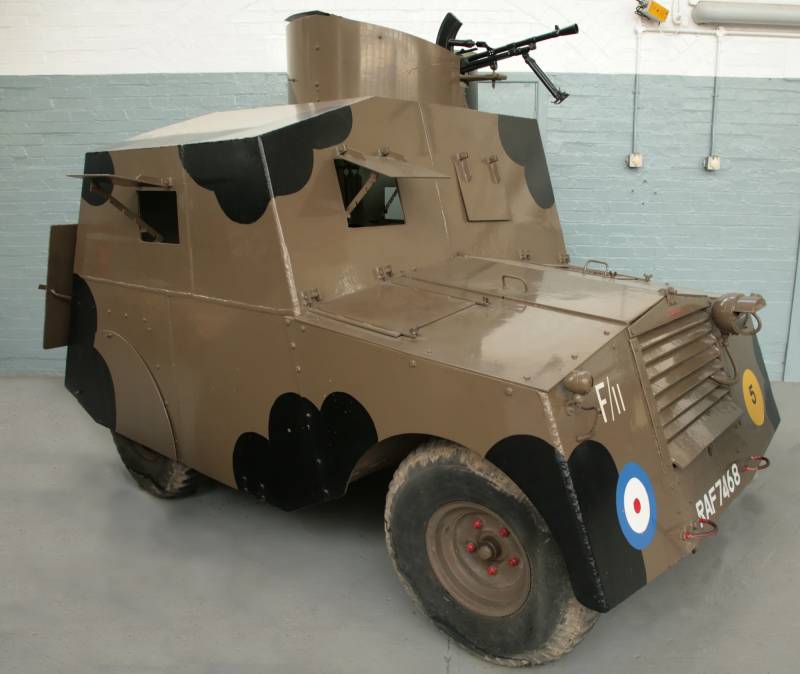
One of the surviving armored vehicles Beaverette Mk III in the Museum of British Duxford. Wikimedia Commons Photos
The relatively quiet operation of armored vehicles, created on the initiative of Lord Bevenbrooke, continued until the very end of the war. After the end of hostilities, the armored cars that were not distinguished by high performance were gradually written off and sent for dismantling. This fate befell almost all cars of the British release, as well as all the available Beaverette (NZ). The equipment of this type was no longer of interest to the army of Great Britain, and therefore its future was predetermined.
Nevertheless, four armored vehicles managed to avoid disposal. Two armored vehicles Beaverette Mk III and the same number of vehicles of the fourth modification are currently museum exhibits. Half of the unique samples are kept in British museums, the other two are in Ireland and the Netherlands. Armored cars of modifications Mk I and Mk II, unfortunately lovers of historical technology, are not preserved.
Armored cars Standard Beaverette were created in one of the most difficult periods and urgently; in fact, they were the answer to the severe challenges of that time. This was the reason for the simplest construction and low cost of production. In terms of their characteristics and capabilities, such armored cars could not compete with “full-fledged” machines of their class, but for the UK 1940 of the year such a vehicle was of great interest. Not the most perfect, but simple and numerous armored cars allowed to partially restore the combat capability in the most difficult period and wait for the appearance of a sufficient number of normal vehicles.
On the materials of the sites:
http://tanks-encyclopedia.com/
http://aviarmor.net/
http://standardmotorclub.org.uk/
http://motor-car.co.uk/
http://cobbatoncombat.co.uk/
Information